-

人教版高中英语必修3Canada-the true north说课稿4篇
Good afternoon, teachers, It’s my great pleasure to be here sharing my lesson with you.The content of my lesson is Senior English Book 3 Unit 5 Canada —— “The true North”.I’ll be ready to begin this lesson from five parts. Analysis of the teaching material,the teaching methods,the studying methods, the teaching procedure,and Blackboard design.First, let me talk about the teaching material.Part 1 Teaching Material:This unit is about the introduction of Canada. By studying of this unit,we’ll enable the students to learn the geography, population, main cities, and natural beauty, natural resources of Canada. Through the training of the unit, it also requires students to learn some Language skills such as the expressions of position and emotions.So it plays an important part in the English teaching in this book.After studying the teaching material and analyzing the rule of children’s growing of mind,I think the teaching aims are the followings:1.Knowledge objects:(1) make the students learn some new words and phrases(2) make the students understand the content of the lesson.2.Ability objects:(1)To develop the Ss’ abilities of listening, speaking, reading and writing. Especially reading and speaking ability.(2) learn to talk about the characters of Canada in English(3)To train the Ss’ ability of working in pairs.3.Emotion objects:(1)Enable students to understand the characters of Canada..(2)Stimulate Ss to work hard to make China stronger.Part 2 Teaching Methods:I think helping students learn to master new words and phrases and improve the students’ reading and speaking ability is import and the difficult.According to the analysis of the teaching material and the import points and the difficult points,I will use the following teaching methods : question-guiding approach; fast-reading and careful reading; multi-media teaching methods; discussion

人教版高中英语必修3Festivals around the World说课稿3篇
Teaching plan for Unit 1 book3Good morning, teachers. It’s my great pleasure to be here because I can share my lesson with you and I can learn a lot from it. I’ll begin my lesson from the following four parts, the teaching material, the teaching methods, the studying methods and the teaching procedure.Firstly, let me talk about the teaching material. The content of my lesson is the reading passage festivals and celebrations of Unit 1 Festivals around the world. This passage is about festivals and celebrations. By studying this passage, we’ll enable the students to know that festivals exit everywhere, and many of festivals in different countries celebrate similar ideas. As we all know, the reading passage is the center of each unit. If the Ss can learn it well, it will be helpful to make the Ss learn the rest of this unit.After studying the teaching material, I think the teaching aims are as the followings:1. Knowledge aims:(1) The Ss can master the usage of the important words andexpressions.(2)The Ss can use the __________________ (grammar) in the proper situation.Make students know about the festivals all over the world and the detail of the festivals, such as origin, content, and the date of the holiday festivals.2. Ability aims:(1) Students can talk about festivals and celebrations in English(2) To improve the student’s reading ability, especially their skimming and scanning ability.3. Emotion aims:Make the Ss know about the foreign festivals, and respect other countries’ custom.Next, let’s come to the important points and the difficult points.The important point is how to make the Ss understand the text better and the difficult point is how can they talk about it. secondly, Teaching Methods:1. task-based Language Teaching2. Computer assisted language teaching.3. question-and–answer methodThirdly, Studying Methods:

人教版高中英语必修4Theme parks说课稿3篇
The oldest and the most popular park in the worldenjoy the exciting activities thereget close to the life-size cartoon characters like Mickey Mouse and Donald Duck Step 3 Pre-reading1.What do you suppose a theme park is ?2.What do you think you can see in a theme park?(1.It is a kind of amusement park which has a certain theme – that the whole park is based on. 2.buildings, castles, statues, rare animals and birds, and so on.) Step 4 Reading ----- Theme Parks –---- Fun and More Than Fun1.Predict : Read the title and the pictures on P. 34 and PredictWhat is the meaning of the title “Theme Park – Fun and more than fun”?(The title means that theme parks are fun to visit, but that they can also be educational and can offer useful information.)2.Skimming Fast read and answer:What activities can we take in a theme park?Amusement park: Bumper car Merry-go-round slide bungee jumping Free-fall rides Horror films Pirate ship Ferris wheel roller coaster3.Scanning Read again and you will find various theme parks are mentioned in the passage . Then what are they ?Theme parks: Sports theme park History theme park Culture theme park Marine or Ocean theme Park Future park Science theme park Disneyland4.Careful reading and find the main idea of each paragraph:THEME PARKS---- entertaining/ educationalPara.1 Traditional parks are places to go for relaxation and to have time away from our busy lives.Para.2 Theme parks are different They’re large and full of things to do, see and buy.Para.3 Theme parks are built around a single idea or theme. One example is a sports park.Para.4 Another kind of theme park is historical more and cultural and can be educational.Para.5 Disneylandwas the first theme park. It is based on the fantasy life and characters of Disney’s films.Para.6 Some examples of educational theme parks include sea world parks and science parks.

人教版高中英语必修4Working The Land说课稿3篇
Knowledge objectives:(1) to make Ss grasp the usage of words, expressions and sentence structures: statistics, struggle, thanks to, rid of, some patterns for persuasion, the “ing” form as subject and object;(2)to use learnt knowledge to persuade sb.Ability objectives:(1) to develop Ss’ reading skills(skimming, scanning, word guessing);(2) to improve Ss’ speaking, communicating and cooperating skills.Emotional objectives:to make Ss know the contribution of Yuan,and learn his spirit and his simple life time.Teaching important and difficult points:(1) some words, expressions and sentence structures mentioned above;(2)the content of the text;(3)training their reading and speaking skills.Teaching methods: CLT, TBLT,QT.Learning strategies: CLS, QLS, TBLS.Teaching procedures:Step 1 lead-in: (1) teacher plays a piece of recent news from CCTV about the harvest of the super hybrid rice, and ask students whether they know Yuan or not, and talk about him and his contribution.(2)Brain storm: let Ss describe Yuan in their minds including his appearance, his living condition and so on.Step 2 fast reading tasks:(1)teacher introduces Yuan and super hybrid rice(2)make Ss read the text as fast as possible with questions. Such as: what’s the general ideaof this passage? What’s Yuan’ dream? (skimming and scanning skill)Step 3 intensive reading tasks(1)let Ss read the text silently, find topic sentence of each paragraph and draw the difficult sentences and the knowledge what they don’t understand.(words guessing)(2)teacher and Ss talk about the important words, expressions and sentences together, and ask Ss to retell the content of the text.(summarizing and paraphrasing)(3)teacher summarize this part.(4) read again following the courseware.

人教版高中英语必修3The million pound bank note说课稿3篇
在接下来的细读环节,我套用了高考对阅读理解的考查方式设置了5个问题,分别为三个推理判断题,一个细节题和一个主旨大意题。学生需要对文章的内容进行分析、归纳、推理、猜测等高级思维活动才能做出正确的回答。【设计意图】这一过程是对学生进行细读的训练,培养学生获取特定信息和挖掘文章深层次信息的能力。第三环节:Intensive-reading (精读) 15′第三个环节精读,既是最重要的环节,也是突破本课重难点的关键。首先,让学生思考剧本中人物看到百万英镑前后的态度发生了怎样的变化。其次,让学生仔细阅读文章,找出可以表现人物态度变化的具体的语言和动作。最后,让学生总结人物的态度发生变化的根本原因是什么,从而引出Money Talks, 供学生思考。【设计意图】通过一系列的活动培养学生学习从人物的语言和动作探究人物的心理,使学生进一步体会戏剧语言的魅力,从而对文章背后所反映的社会问题进行思考,也为下一步的讨论环节做好铺垫。

人教版高中英语必修5Great scientists说课稿4篇
通过写文章梗概,培养学生综合运用语言的能力,学习用恰当的英语描述科学家的故事。这是本课的教学难点。教师可以使用完形填空的方式来帮助学生整理语篇,从而来降低难度。本课的教学重点的突破方法是:在阅读前,让学生初步了解得出科学观点所需要的基本程序,从而轻松而自然地导入文章的阅读;在阅读过程中,由易到难设计快速阅读和精读的问题,层层推进各种阅读活动,让学生对阅读内容从整体感知到细节理解,最后深层读懂整篇文章,同时加强阅读策略的指导,让每个学生都主动参与课堂教学活动,最终达到提高阅读能力的目的。Step 4 Post-readingGroup Activities四人小组共同合作,在老师的适当指导下,就以下2个问题展开讨论,让学生就所知、所学、所感和所想融入话题,然后抽若干同学代表作小组发言。1. What do you think about John Snow, and what should we learn from him?2. Cholera was 19th century disease, which two diseases are similar to cholera today? Why?

人教版高中英语必修5Life in the Future说课稿5篇
Good afternoon, everyone. It’s my great pleasure to be here sharing my lesson with you. The content of my lesson is Senior English for China Book5 Unit 3 Life in the Future. I’ll be ready to begin this lesson from six parts: Analysis of the teaching material, Analysis of the students, Teaching aims and important and difficult points, Teaching methods and aids, Teaching procedures, and Blackboard design. First, let me talk about the teaching material.Part 1 Analysis of the Teaching Material:This unit is about what human beings’ life will be like in about one thousand years. By studying of this unit, we’ll Enable the students to know the changes in humans’ life and some new inventions bringing about the change and develop the interest in science. This lesson plays an important part in the English teaching in this unit. This is an important lesson in Book Five. From this lesson, it starts asking the Ss to grasp contents of each passage. Therefore, this lesson is in the important position of the teaching material. If the Ss can learn it well, it will be helpful to make the Ss learn the rest of this unit.Part 2 Analysis of the SsAs Senior2 Ss, they are at different levels of English fluency, some of them have lost interest in English. So during the lesson, I arrange a variety of activities to let all of them join in to attract their interest and let them be confident and taste the joy of success.

人教版高中英语必修5The United Kingdom说课稿4篇
Teaching Aims:Knowledge 1. Get the students to learn the useful new words and expressions in this section. Aims:2. Let the students learn about how the UK was formed and the four groups of invaders.1. Develop students’ reading ability and let them learn different Ability reading skills. Aims:2. Enable students to learn to talk about the United Kingdom and the Union Jack Emotional 1. Let students know more about the UK2. Develop students’ sense of cooperative learning Aims:Teaching Important Points:1. Let the students learn about the countries of the United Kingdom and the Union Jack2. Get the students to read the passage and know about how the UK was formed and the four groups of invaders.3. Have the students learn different reading skills.Teaching Difficult Ponts:1. Develop students’ reading ability.2. Enable students to talk about the United Kingdom and the Union Jack.3. Let students learn how the UK was formed geographically and historically.Teaching Methods:Showing pictures, asking, exercising, listening, reading etc.Teaching Aids:A computer,a projector and a blackboard.Teaching Procedures: 1) Show a map of the world, ask students the following questions:Where is the UK?What’s the full name of the UK?2) Ask the students work in pairs to do the quiz on Page 9.Do you want to test how many things you know about the United Kingdom? Let’s have a small test.Using the map on P9, students answer the following questions:?How many countries does the UK consist of? What are they??England is divided into three main areas. Do you know what they are? 1) Scanning (10Minutes )Let the students hold the questions asked in pre-reading and read the passagequickly and then let them do the following exercise.Join lines to the right answer.
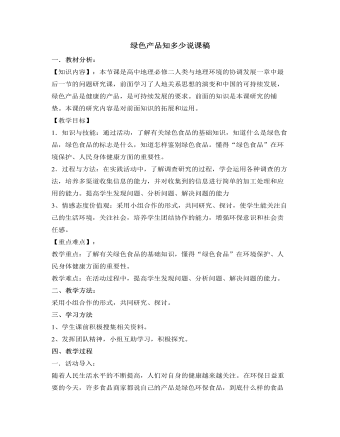
人教版高中地理必修2绿色产品知多少说课稿
各小组派代表汇报。4、教师提出问题组织学生讨论:⑴要想了解更多的绿色食品,了解绿色食品的销售情况,我们应该怎么做?⑵要想了解广大消费者对绿色食品的态度,食用绿色食品的意义,是否懂得辨认绿色食品,以及什么样的人群对此知识最缺乏等,我们应该怎么做?组织学生汇报交流。5、做个“绿色食品”广告设计师。为你喜欢的绿色食品设计广告语,每组推荐一个。6、让学生了解绿色食品认证程序。7、绿色食品打“假”队员在行动。8、向学生介绍生态绿色食品基地。三、活动总结:通过研究、探讨,了解学生对绿色食品的态度。提问:民以食为天,吃,是一个大问题,如果你的爸爸妈妈让你到超市买牛奶、方便面等,你会选择什么样的食品?为什么?希望通过今天的学习,同学们能够做到绿色消费,也希望你们向自己的家人、向周围的了解学生对“无公害食品”、“有机食品”与“绿色食品”的认识。
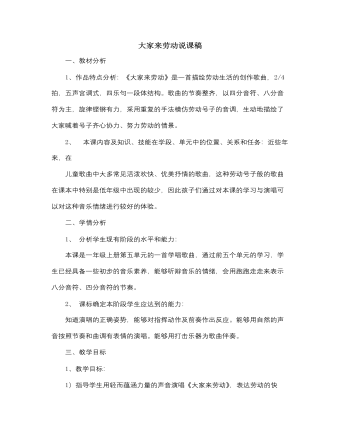
人音版小学音乐一年级上大家来劳动说课稿
2、师:"今天的音乐课上老师要带大家一起来劳动(出示课题),同学们有修桌子的叮当叮当、有擦桌子的擦擦,还有扫地的刷刷(按顺序出示节奏),让我们大家一起行动起来,加入劳动的行列。用劳动的声音来读一读,看看谁读的最准确。"(学生用劳动的声音来读的节奏实际就是歌曲的节奏,用这种方式可以让学生在潜移默化中学会歌曲中的重点节奏)[课件节奏谱]1)学生分三组按顺序读,一组读修桌子节奏,一组读擦桌子节奏,一组读扫地节奏。(这样做是为了培养学生相互配合、协作的能力)2)集体连读三、歌曲学习1、感受歌曲情绪1)师:"同学们读的很准确,反应很灵敏。看得出你们在劳动时也是非常卖力的,现在老师也想为你们这些劳动的小能手鼓劲,请你们听听老师是怎样表示的?"[课件出示前两句歌词](难点)师拿响板边拍边读:嗨哟加把劲呦,嗨哟里格嗨哟呵呵师:"刚才老师怎样为小能手加油的?"学生:嗨哟······师:你们能不能
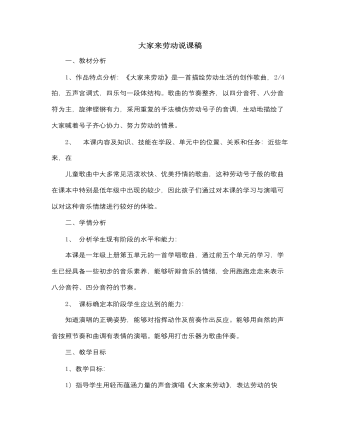
人音版小学音乐一年级上袋鼠说课稿
设计意图:幼儿听着音乐磁带边表演边唱,把自己想象是一只小袋鼠,能用自己的动作非常投入地表演起来,这种耳闻目染的熏陶,一下子就将幼儿身心带进音乐的殿堂,群情激动,气氛达到高潮。4、感受猎人打枪及狼中枪后的游戏规则:(1)音乐结束,猎人打枪,狼倒下。(2)猎人检查狼是否死了。假如有袋鼠动了,狼就立即爬起抓住袋鼠,老师问:这只袋鼠为什么被狼抓住?(猎人开枪后,还没有检查狼是不是死了,袋鼠就动了。而这只狼很狡猾,它装死,实际上它还没有死,它看见袋鼠动了,就扑过去把它捉住了)猎人随机又开枪,将大灰狼打死。老师旁白:“狼死了没有,还不知道呢?小袋鼠可千万不能动。”猎人检查完后,说“大灰狼被打死了!”老师带领小袋鼠欢呼:“大灰狼被打死了!”,听歌曲《袋鼠》高高兴兴回家。5、幼儿完整玩游戏。进一步强调游戏规则。6、结束部分:“大灰狼被打死了!” “大灰狼被打死了!”,听歌曲《袋鼠》小袋鼠跟着妈妈高高兴兴回家。
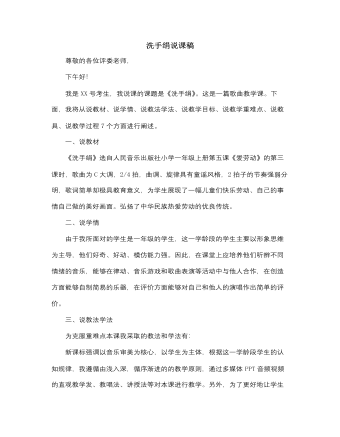
人音版小学音乐一年级上洗手绢说课稿
理论离不开实践,这个环节,为了让学生更好地体验歌曲的民谣风格,并且亲身践行自己的事情自己做和感受劳动的快乐,我将学生分成4个小组,随意解下自己的红领巾,放在讲台上事先准备的洗衣盆里清洗,并对歌词进行改编套入本曲中,边唱边洗,当唱到休止符时,要求他们做一个拧干水的动作,如:2/4 1 1 2 1 1 2 3 2 3 0: 哎 啰 哎 啰 哎 啰 哎 拧水让学生感受本曲中歌词及休止符带来的劳动感。接着,让学生对自己及他人的表现进行自评与他评,最后我来评价哪组洗的最好。让学生在做中学。最后,是我本课的教学总结本课教学,我运用了柯达伊体态律动教学法、示范法、讲授法、多媒体展示法和活动创编等方法,引导学生从多角度、多方面、多层次去体验音乐情感,通过柯达伊的律动教学,触动学生的音乐连觉反应,使其有本能的音乐反应,对学生以后形成正确的音乐学习观有着积极影响。
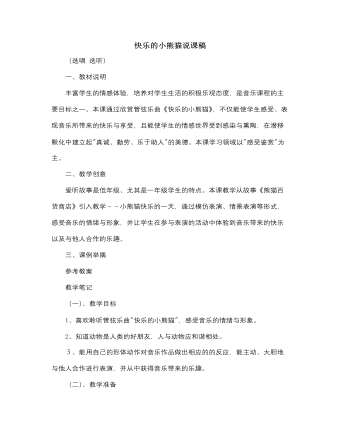
人音版小学音乐一年级上快乐的小熊猫说课稿
(时间不早了,森林里顿时热闹起来,小动物们在干什么呢?)·聆听: 听音乐第二段,感受音乐轻快的情绪。生根据自己对音乐的理解与想象回答。然后再视听结合,播放小鸟飞、在大树上叽叽喳喳的情景,进一步感受此段音乐特点,并随音乐表演。(小熊猫也出发了,看!哥弟俩抬着水桶去打水呢)。·听赏音乐第三段。感受活泼明快的"熊猫主题"。·鼓励学生模仿小熊猫打水、抬水的样子,并随音乐表演,体验音乐所表现的情绪与形象。3、完整聆听多媒体完整播放音乐及画面,学生整体感受音乐所描述的情景,同时培养学生良好的聆听音乐的习惯。4、情景表演学生选择自己喜欢的头饰,扮演动物角色,分小组随音乐进行情景表演,体验音乐带来的乐趣及与他人合作的快乐。5、评价反思、德育渗透。(四)、其他选择1、本课开始部分可用猜谜语导入。2、教师可以先让学生完整欣赏音乐,让学生根据音乐想象描述的情节,再分段欣赏。
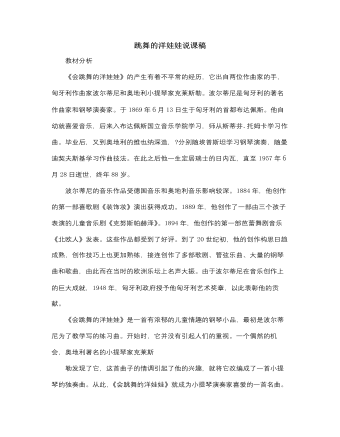
人音版小学音乐一年级上跳舞的洋娃娃说课稿
乐曲是三部曲式,D大调,3/8拍,快板。乐曲开始是一个短小的引子,由钢琴演奏。前面的5小节之后,小提琴从弱拍进入,用弹跳式的弓法演奏,由这里开始的一系列16分音符和8分音符,都加有顿音记号,取得了绝妙的效果,把洋娃娃那可爱、活泼,又有几分笨拙、机械的动作描绘得活灵活现。B段转A大调。曲调优美、婉转,在性格上它与A段形成鲜明的对比。后半部分在调性上做文章,使乐曲产生了色彩斑斓的效果:然后A段再现,最后轻快地结束全曲。学生会很喜欢这首小曲,从中感受小提琴的音色,感受乐曲活泼欢快与优美抒情的对比。 聆听《会跳舞的洋娃娃》教学基本要求1.完整聆听乐曲,感受乐曲的情绪。2.乐曲是由什么乐器演奏的?乐曲的洋娃娃怎样跳舞,请你用动作表现出来。3.复听乐曲,一部分同学随着音乐做动作。用手半握拳敲击节拍。一部分学生可随着音乐用手指按图谱划动,感受乐曲的快慢。
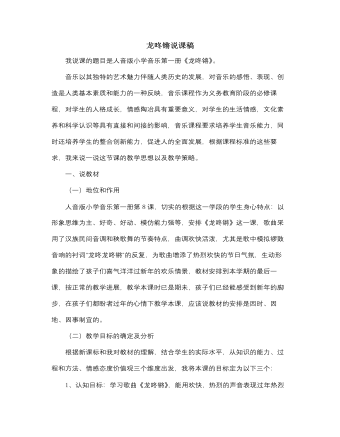
人音版小学音乐一年级上龙咚锵说课稿
五、教学特色(总结以上过程和策略,我认为我的教学特色是)1、面向全体学生,突出学科特点。2、创造合作互动,尊重独特体验。3、运用现代手段,实现学科整合。六、板书设计我采用了图文式板书——清晰明了,具有艺术性、启发性,将难点进行突破,形象生动,让学生一目了然。七、教学启示总之,本方案设计,力求体现以人为本的思想,着眼于学生的主动发展,致力于运用现代信息技术优化课堂教学,通过充分的音乐实践培养学生的能力,提高音乐素养,依托音乐本身的魅力,影响学生人生观、审美观、价值观的形成,培养学生主动学习、合作意识,探究精神,从目标的提出到过程的安排,学习方法的确定,乃至学习成果的呈现都让学生有更大的自主性,更多的实践性,更浓的创造性,当然,措施付诸实施,还需要老师的爱心和慧心,教学研究永无止境,我相信,没有最好,只有更好,在此,还请各位老师和同行们提出宝贵意见,谢谢!
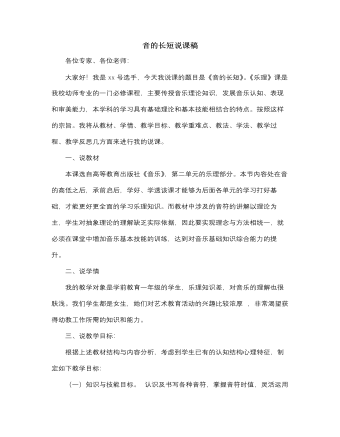
人音版小学音乐一年级上音的长短说课稿
第五个环节:最后播放一段音画视频,儿童舞蹈《数鸭子》,让全体同学跟着音乐哼唱儿歌,让她们感觉回到了自己的童年时代。让学生即兴创编舞蹈动作,并上台表演。这样,使学生在律动中获得身心愉悦,把整节课堂气氛推向了高潮。并在欢乐的歌舞声中结束。接下来说说我的作业布置情况: 1、知识巩固性的作业,做练习题书中P37页第一题,第二题。2、拓展性作业,收集儿歌《》《》《》并找出音符在其乐曲中的长短。七、板书设计(一)黑板中央上方写上题目——音的长短。(二)左上方依次写下单纯音符、几种常见音符及其形状。(三)画出各音符之间的时值比例关系图。(四)右边画出音符及其时值和单位拍的对照表。八、教学反思最后我就说说教学反思,本节课的教学围绕着学生想、听、唱、跳这样的动作层层推进。调动了学生的学习热情,关注学生的个性发展。激发了学生学习音乐的兴趣,增强她们的基本技能,为以后从事幼教工作打下坚定的基础。最后以一句歌词,来结束我的说课。
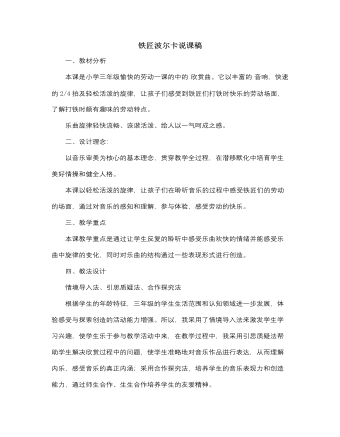
人音版小学音乐一年级下铁匠波尔卡说课稿
接受能力强的学生分为一组,让他们互相监督自己练习;接受能力弱的学生分为一组,老师进行个别教育。 通过分组教学得到因材施教的作用。(用传统的跟学法让学生直观地学会边歌曲边表演动作。通过分组教学得到因材施教和学生自主学习的效果。)(四)师生一起边唱边跳互动表演。(通过尽情的表演让学生张扬个性,满足孩子的表演欲望。)(五)课后作业:课后练习边唱《粉刷匠》边跳舞。(让学生学习的内容得到巩固。)(六)课堂延伸和总结 小粉刷匠热爱劳动,不怕脏不拍累,小朋友们向他学习,在学校要主动打扫卫生,在家要积极做自己力所能及的家务活,做一个爱劳动的好孩子。 (延伸课堂内容,提高教学效果。)总之,在这些活动中,更重要的是我们的学生能通过自身的感受、体验而获得情感审美上的升华,提高他们的动作协调性,为热爱音乐、热爱艺术、热爱生活打下良好基础。
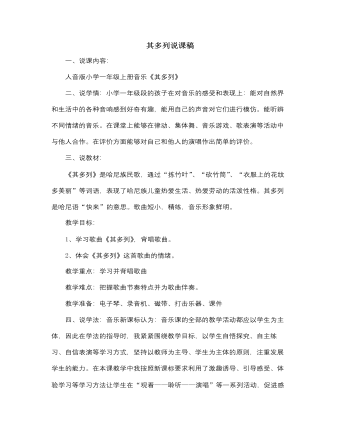
人音版小学音乐一年级上其多列说课稿
1、一堂课必须有一个好的导入做为前奏,来调动学习兴趣,在这一课的教学过程中导入部分我利用了北京奥运会升旗仪式的一个片段让学生感受56个民族团结在一起的美好场面。接着我用多媒体课件让学生认识了几个比较有特点的少数民族来导入本课的主课题《其多列》。2、音乐是听觉的艺术,音乐教育首先要解决的问题是要学生学会聆听,使学生养成聆听的习惯逐步拥有音乐的耳朵,是我们音乐教师不可推卸的责任,因此在学唱歌曲时我设计了以下几个环节:(1)、初听全曲。让学生在歌词和音调中感受歌曲的风格特点。(2)、再次听全曲。让学生在模仿劳动时的动作来感受歌曲的节奏特点。(3)、看课件欣赏全曲。通过对歌曲动画的欣赏,加深学生对歌曲的整体感,对学习歌词奠定基础。(4)、在学习歌词过程中,我以一个提问者的身份,并利用键盘让学生边听琴声边轻声逐步掌握歌词,
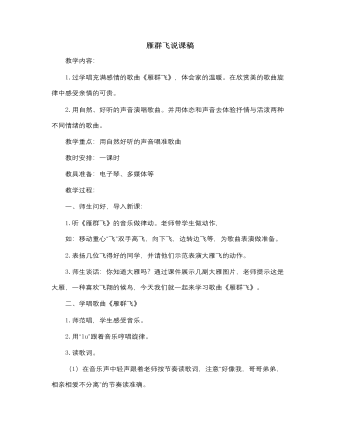
人音版小学音乐一年级下雁群飞说课稿
(1)在音乐声中轻声跟着老师按节奏读歌词,注意“好像我,哥哥弟弟,相亲相爱不分离”的节奏读准确。(2)老师读上半句,学生读下半句。4.逐句教唱,解决难点乐句“飞来飞去不分离”。5.找出旋律相同的两句,用不同的图形或字母表示出来,如:ABA。6.《雁群飞》是一首优美抒情的歌曲,应该用什么样的声音和感情演唱歌曲呢?学生说一说,有感情的演唱歌曲。7.分小组进行简单的动作创编,注意表现出歌曲中的相同与不同。8.学生表演。9.教师与学生一起评一评。三、教师小结。教后记:为了能让学生理解到歌曲的结构,我设问,“歌曲中哪些地方是重复的?”学生经过老师的引导,用笔勾画出了歌曲中重复的乐句。这时我形象地比喻道,它的结构有点像我哦们吃的“肉夹馍”,两边是馍中间有一块好吃的肉,学生一下哈哈大笑起来,还不时地回味说,“真像‘肉夹馍’。”听到这样的回答,我想学生一定对歌曲的结构有了清晰的认识。
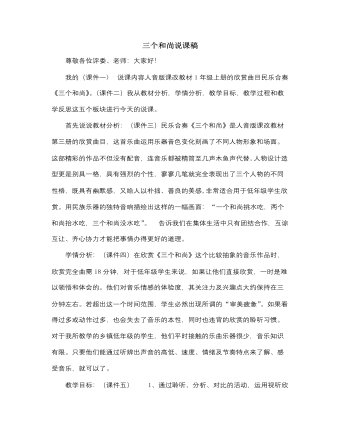
人音版小学音乐一年级上三个和尚说课稿
3.请几组同学表演这几个的场面,其他同学做评委,从模仿表演中享受学习音乐的快乐。五.课堂小结 (阶段目标:以“我的收获”(课件十)帮助学生总结所学内容,知道音乐中,不同的音乐要素可以表现不同的人物、场面)课后反思:(课件十一)在本节音乐欣赏教学中,我坚持以“听”为核心(因为音乐是一门听觉艺术),让学生“带着问题听”、“想着听”、“动着听”、“演着听”等多元化的“听”的形式。一系列“听”的任务不仅提高学生的注意力,而且提高学生“听”的兴趣与“听”的质量。而且我创造和谐的课堂气氛,积极引导学生把对音乐的内心感受大胆地用语言表达出来,让学生主动参与音乐快乐学习的实践中去,创建出有利于学生发展的生动活泼的音乐课堂情景,让学生的了解音乐,感受音乐,融入音乐。